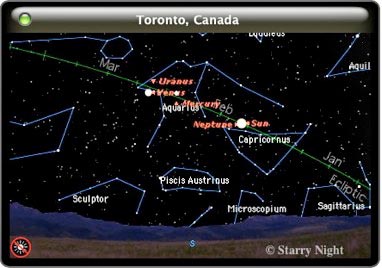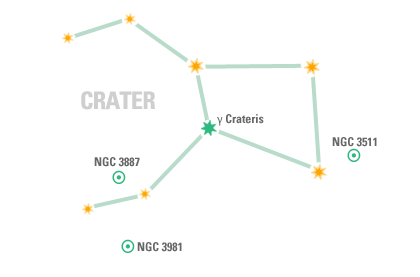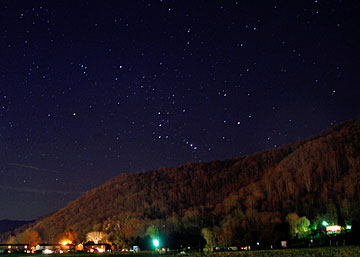 |
||||||||||||||||||||||||||||||||||||||||||||||||||||||||||||||||||||||||||||||||||||||||||||
|
If you have trouble viewing this newsletter, click here. Welcome again to our monthly newsletter with features on exciting celestial events, product reviews, tips & tricks, and a monthly sky calendar. We hope you enjoy it!
Popular Science magazine aviation editor Eric Adams praises Starry Night® Version 6 in his round-up for CNN.com article “High-tech gadgets for stargazers” posted March 15, 2007:
You can read the full article at CNN.com. Linda Fung
Imaginova Corp., publisher of Starry Night® astronomy software, announces the successful launch of the Starry Night® Widget, a small web application that delivers the stars and planets visible from any location on Earth directly to your desktop. The Starry Night® Widget for Mac OS® X Dashboard rocketed to #1 of Apple’s Dashboard downloads on its first day. It remains in the Top 5, delivering over 2 million sky images daily to users worldwide. “The Starry Night® Widget is a showcase of Starry Night®’s new web-delivery capabilities,” said Seth Meyers, Vice President and General Manager, Imaginova Studios. “The success of the Widget indicates the demand for science-related content. The Starry Night® Server, which supplies the sky images for the Widget, can be configured to serve a wide variety of desktop and handheld platforms.” Users of the Starry Night® Widget set their location by ZIP/postal code or by latitude and longitude, and the Widget flips to show a view of the current sky. They can customize their view to show constellations, the horizon, the ecliptic line and labels for the celestial sights above. The Starry Night® Server delivers a new sky image every few minutes. The Starry Night® Server also powers Starry Night® Online, the highly interactive planetarium applet that can be found at www.space.com/nightsky/. Starry Night® Online allows users to see the stars and planets from any location on Earth for any time in the past, present or future. Starry Night® Online is only a sampling of the stunning simulations and 3-D renderings that the full line of Starry Night®’s award-winning desktop software has to offer. The Starry Night® Widget can be downloaded for free from StarryNight.com or Apple.com. Linda Fung
Starry Night® Middle School and High School have recently been accredited by Smart™ Technologies Inc. at the “SMART Board™ Interactive Whiteboard Ready” level. Accreditation at the “Ready” level means that SMART Technologies finds Starry Night® easy-to-use, intuitive and interactive. All the keyboard controls can be implemented with the SMART Board software on-screen keyboard, and the interface buttons and text are of sufficient size to be easily activated on a SMART Board interactive whiteboard. If you have a SMART Board in your classroom, Starry Night® Middle School or High School will be a great addition to help you teach your space science unit.
55th Annual National Science Teachers Association National Conference Stop by for a preview of Starry Night® Elementary and a “Honk if Pluto’s a Planet” bumper sticker. Attend any one of our 8 workshops! Linda Fung
Are you looking for it, too? It’s that frustrating time of year again. As the Northern Hemisphere rolls away from winter we eagerly await signs of spring. For many, spring comes with returning robins bobbing along the ground in a spirited hunt for lunch. For others it’s spring flowers putting in a first appearance. But the most reliable sign of spring is not of the Earth, but of the sky. It is the stars of Leo. Leo the lion is a prominent spring constellation. When I see Leo riding high in the southern sky before midnight (figure 1), I know that Earth has not stalled in its yearly orbit and we are not stuck in perpetual winter.
Figure 1. The constellation of Leo is a rich hunting ground for sky gazers with telescopes. This part of the sky is relatively poor in stars but rich in galaxies. At night, we face away from the Sun. Our nighttime view changes through the year. As Earth orbits around the Sun our view sweeps through the yearly cycle of seasonal constellations. The solar system is tilted compared to the plane of the galaxy (figure 2), and this also affects what we see as we look out into the stars. During spring nights we face away from the rich star fields of our galaxy. The Milky Way hugs the western horizon and our view is up and out of the galaxy (figure 3). This gives us a clear view into the deeps of intergalactic space. In spring, the rest of the universe is on display. There is little interference from the Milky Way’s intervening clouds of gas, dust and stars. Millions of external galaxies glow faintly in the blackness of space, beckoning telescopes to reveal their splendor. Astronomers answer the call of the galaxies each spring with eager enthusiasm. Leo and its neighboring constellations are rich territory for observers wanting to soak up photons from hundreds of millions of light years away. Such intergalactic communion is an experience like none other.
Figure 2. Earth orbits in the plane of the solar system, which is tiled with respect to the plane of the Milky Way. This is why our view of the Milky Way changes dramatically throughout the year. The Milky Way is seen here as a glowing cloud in the background, stretching diagonally from the upper left toward the lower right of the image. The purple line marks the central plane of our galaxy.
Figure 3. From high above Earth we can see North America in the shadow of night while Europe and Africa, on the right limb of the planet, are in daylight. North Americans looking into the night sky are looking away from the plane of the galaxy. The galaxy appears as a glowing cloud running vertically through the image below Earth. The purple line represents the central plane of the Milky Way. The curving green line at top, on which the Sun is located, marks the ecliptic – the plane of the solar system. We all have our favorite signs of spring. This year spring arrived officially on March 21 at seven minutes after midnight Universal Time. For sky gazers, spring is synonymous with the arrival of Leo and a sky blooming with galaxies. The celestial lion is the surest signal that terrestrial blossoms will soon follow. Mary Lou Whitehorne
Messier Marathon is a term describing the attempt to find as many of the Messier objects as possible in a single night. A marathon held on Saturday, March 17, 2007 promised the prospect of observing all 110 objects in one night. Let's see how Jeff Barbour made out... Messier Marathon: What Really Happened? Messier's 'Year in a Night' has come and gone and now you're left wondering why you didn't find all 110 on your first outing. The reasons are simple. Sky conditions trump everything, and the spot you chose to observe from introduces its own peculiarities. But you're tough enough to handle the truth. Even if you'd been observing from the surface of the Moon, you might have missed a few.
On the Moon, there'd be no trees and foliage to block the horizon. You'd be able to sweep the scope all the way across that 180 degree vault of the heavens and nothing would make an obstacle of itself. But a clear horizon is possible on Earth too. There are seas, mountains, and deserts enough that you could find the wide open spaces needed for a Messier Marathon. How wide open was your site? Probably more foliage than you'd care for. But the Earth, unlike the Moon has other complicating factors as well. The Moon is free of atmospheric gases. There's nothing floating above the lunar surface to absorb, scatter, or disturb light in any way. From the dark half of the Moon, your fully dilated and dark-adapted eyes could capture starlight as faint as magnitude 8! How's that for seeing? I'll bet you weren't going that deep where you were observing from—regardless of the horizon. In fact if you could see overhead stars to magnitude 5.5 without trouble, you were blessed with some pretty fine conditions! And if you weren't? That's one very good reason why you fell a few shy of 110. Theoretically, if you could see stars to magnitude 8 unaided, you could also see more than 60% of the Messiers without any instrumentation whatsoever. But first you'd have to know precisely where to look, and more importantly what to look for! Distinguishing 8th magnitude anything's from stars might be a bit much to ask from those 1x7 binoculars you were born with. Besides, you'd need astronomical binoculars anyway if only to make out the other 40%. Meanwhile, a little extra magnification comes in useful when distinguishing stars from star clusters. Bottom line: Seeing isn't finding, and sometimes finding isn't seeing! Now let's get back down to earth again. Because the Earth has an atmosphere, there are some things you have to consider with or without that unobstructed skyline. First, even though the length of the day and night are roughly equal in March, the sky doesn't really start to get dark until astronomical dusk. Professional astronomers don't even think of arriving at the observatory until the Sun is at least 18 degrees below the horizon. Why? Because astronomical dusk doesn't start until 72 minutes after sunset! A marathon typically starts about one hour after sunset and may not end until half an hour before sunrise!
During a Messier Marathon, you have to make some trade-offs—both ends of the night. Those trade-offs are between sky position and sky transparency. If you start your marathon too early, the sky is too bright to make out low average surface brightness galaxies like M74 in Pisces despite the fact that earlier than this M74 would be positioned higher in the sky where things normally show up better. But if you start too late, the Earth's thicker, more dust-laden atmosphere down low reduces contrast between the galaxy and background sky. Similarly challenging in this way is equally low average surface brightness Triangulum Galaxy M33. (Both galaxies have an average brightness of magnitude 13.9.) So when is the best time to start? That depends on sky conditions. A really transparent sky gives you more of an observing window. A poor sky can offer no observing window whatsoever! You have to nail it anywhere in between. So how was your sky? One way to tell how things are shaping up is to turn your telescope on Polaris. Use whatever magnification will give you a one degree true field—that means roughly 60x (through most modern wide-field eyepieces). Keep checking for Polaris' companion until things darken enough to see it direct (without averting your vision). On a good night, you should just make out Polaris-B 45 minutes after sunset. Once you see Polaris-B, swing the scope around on Castor in Gemini. A clean split at the same magnification means the sky is nice and stable. Stability means less dust and light scatter nearer the horizon when you head off after the early toughies like M74, 110 and 33. Having resolved Polaris and Castor you were toeing the starting line but not tensing any muscles. It was another 15 minutes before you were off and walkin' the night sky. By 7:00pm however, you were listening for the start gun. Did you find 3.7 magnitude Eta Piscium unaided? Even so, you probably swept the sky nearby and found nothing? How'd you miss M74? Was the sky still too bright? Or did you move the scope in the wrong direction, say slightly south and west rather than north and east? Maybe your eyes weren't dark-adapted enough? Or perhaps M74 was much fainter than you remember? Did you double check the charts and try again? After a few more sweeps for M74, you probably decided to move on to M77. Funny, I don't remember M77 being that faint! Being the persevering sort, you returned once again to Eta and followed the star west until it sunk into the foliage. Better luck next year! The fact that you did find M77 was a confidence boost but the thought of missing one right out of the box let some of the heat out of your balloon. But you did push on determined to find the next three.
So the score was 3 to 2 in the first inning with a tough batter stepping up to the plate, M33. How'd you do there? Located some 30 degrees above the horizon 90 minutes after sunset, M33 should be well above the trees yet, due to the fact that there are few neighboring bright stars, tracking it down was tough! Although M33 is faint, you didn't stand a chance if you couldn't locate it in the sky. If not, next time around try this; M33 is roughly the same distance along a line extended from M31 through 2.4 magnitude Mirach in Andromeda. Keep in mind that you have as much of a chance of seeing M33 in that 50mm finder scope as at 60x through the big dob. Over the next year, see how many Messiers you can spot through the finder alone. Only about a dozen or so will elude you, more if you're not sure what to look for at low power. Over the rest of the evening things went well enough, except that you may have misidentified a few of the Coma-Virgo galaxies. Did you feel tempted to gloss over a few? Or did you painstakingly pick your way through those 14 galaxies without a hitch? Here's where self-honesty comes to play. One of the greatest skills you'll ever learn in observing is how to tell the difference between really finding something or 'just guessing'. If knowledge is power, then guesswork is a blown fuse. After midnight things became sheer observing pleasure but later came rosy-fingered dawn and the delight she took in veiling the stars. Like the evening before, there were three tough Messiers to track down at magnitude 9.4, M72 is the faintest of all Messier globular clusters. Meanwhile nearby M73 like M40 in Ursa Major is one of those 'anomalous' discoveries that looked like a 'faint fuzzy' in Messier's spindly long-focus, small-aperture refractory telescope. Then there was that brighter M30 globular cluster struggling to clear the tree line ahead of dawn's later light. You probably had trouble finding M72 simply because it's so faint especially if you were rushing or using a smaller instrument. You'd miss M73 primarily because it is a tiny group of easily overlooked 10th through 12th magnitude stars. M30 was purely a matter of observing locale although navigation in the hinterlands can be a bit of challenge as well. So how'd you do? Triple-figures would be a great start! But frankly the real win here was the fact that somehow despite the rush and technicalities of observing you spent a whole night with good friends under the Night Sky. And that's what it really was about, wasn't it? Jeff Barbour
Crater is a dim constellation that glides across the southern horizon at this time of year. It lies to the west of Corvus, above Hydra, and below the boundary between Virgo and Leo. Three faint galaxies are worth bagging and comparing...
Lastly, γ Crateris is a pretty 4th magnitude fixed binary star that should be fairly easy to "split" in your telescope. Sean O'Dwyer
Orion Rising over Lynn Mountain near Elizabethton, TN taken by Larry Souders. Shot with a Canon EOS 1D Mark IIn 400 ISO 30 seconds at f 3.5.
PRIZES AND RULES: We would like to invite all Starry Night® users to send their quality astronomy photographs to be considered for use in our monthly newsletter.
Please read the following guidelines and see the submission e-mail address below.
|
April 2007
|
|||||||||||||||||||||||||||||||||||||||||||||||||||||||||||||||||||||||||||||||||||||||||||
 |
||||||||||||||||||||||||||||||||||||||||||||||||||||||||||||||||||||||||||||||||||||||||||||
|
|
||||||||||||||||||||||||||||||||||||||||||||||||||||||||||||||||||||||||||||||||||||||||||||
You have received this e-mail as a trial user of Starry Night® Digital Download
or as a registrant at starrynight.com. To unsubscribe, click here.














